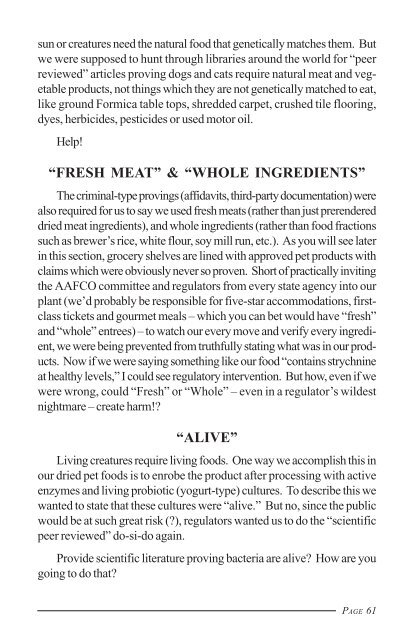The-Truth-About-Pet-Foods
The-Truth-About-Pet-Foods
The-Truth-About-Pet-Foods
You also want an ePaper? Increase the reach of your titles
YUMPU automatically turns print PDFs into web optimized ePapers that Google loves.
sun or creatures need the natural food that genetically matches them. But<br />
we were supposed to hunt through libraries around the world for “peer<br />
reviewed” articles proving dogs and cats require natural meat and vegetable<br />
products, not things which they are not genetically matched to eat,<br />
like ground Formica table tops, shredded carpet, crushed tile flooring,<br />
dyes, herbicides, pesticides or used motor oil.<br />
Help!<br />
“FRESH MEAT” & “WHOLE INGREDIENTS”<br />
<strong>The</strong> criminal-type provings (affidavits, third-party documentation) were<br />
also required for us to say we used fresh meats (rather than just prerendered<br />
dried meat ingredients), and whole ingredients (rather than food fractions<br />
such as brewer’s rice, white flour, soy mill run, etc.). As you will see later<br />
in this section, grocery shelves are lined with approved pet products with<br />
claims which were obviously never so proven. Short of practically inviting<br />
the AAFCO committee and regulators from every state agency into our<br />
plant (we’d probably be responsible for five-star accommodations, firstclass<br />
tickets and gourmet meals – which you can bet would have “fresh”<br />
and “whole” entrees) – to watch our every move and verify every ingredient,<br />
we were being prevented from truthfully stating what was in our products.<br />
Now if we were saying something like our food “contains strychnine<br />
at healthy levels,” I could see regulatory intervention. But how, even if we<br />
were wrong, could “Fresh” or “Whole” – even in a regulator’s wildest<br />
nightmare – create harm!<br />
“ALIVE”<br />
Living creatures require living foods. One way we accomplish this in<br />
our dried pet foods is to enrobe the product after processing with active<br />
enzymes and living probiotic (yogurt-type) cultures. To describe this we<br />
wanted to state that these cultures were “alive.” But no, since the public<br />
would be at such great risk (), regulators wanted us to do the “scientific<br />
peer reviewed” do-si-do again.<br />
Provide scientific literature proving bacteria are alive How are you<br />
going to do that<br />
PAGE 61


